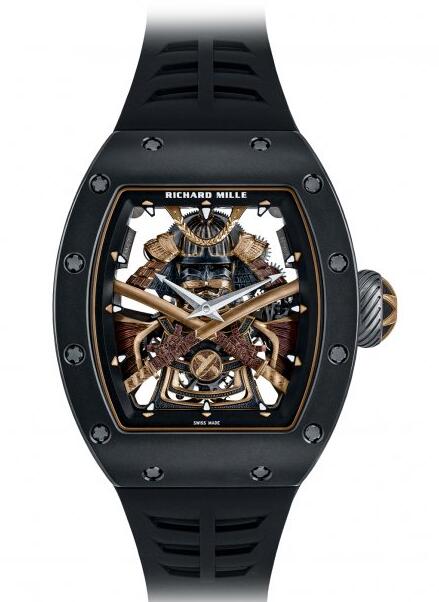
As an aesthetic masterpiece that pays homage to Japanese culture, it came out stunningly after four years of deliberation and careful design. The inspiration for the birth of this watch came from a cordial conversation between Mr. Richard Mille and his close friend Fernando Alonso. The two-time F1 world champion, the hall-class driver, turned out to be a fan of traditional Japanese art and samurai spirit. The design inspiration thrown by him is full of Japanese samurai details. It is unexpected that Alonso’s knowledge of traditional Japanese texts is so rich!
The RM 47 Tourbillon watch traces the origin of traditional Japanese craftsmanship and reproduces the allusions of Bushido. The moral code conveyed by the samurai spirit still prevails in Japanese society today. In the center of the RM 47 Tourbillon, the samurai armor with the Asano family crest is clearly visible. The Asano family originated in Hiroshima and is a symbol of Bushido spirit. At the beginning of the 18th century, Asano Naganori was also a lord followed by the forty-seven ronin. After avenging the death of the lord, these ronin resolutely followed the lord and died. Each samurai family has their own unique family crest, which is printed on their clothes, saber and vassal flag, and accompanies them in battle. The watch is also on the tourbillon at 6 o’clock, decorated with the Asano family crest, which is composed of two intersecting eagle feathers, and is also finely engraved on the winglet of the samurai helmet. In Japanese feudal totems, the falcon symbolizes war power and lordship.
The bold three-dimensional design of the RM 47 Tourbillon makes the dial sculpture stand out, leaving an impression that sculpture and engraving are integrated. The samurai armor in 3N gold, hand-carved by Pierre-Alain Lozeron, protects the RM47 movement. The three-dimensionality of the work is the key, so it is necessary to create a two-sword warrior image with visual depth in the form of a visual trap (trompe-l’œil). The tourbillon is adorned with a wealth of intricate details, including the helmet reinforcement straps, the pendant on the knife, the two falcon feathers crossed in the family crest, and the mask expression that fully embodies the spirit of the samurai. The samurai armor consists of 11 parts and took more than 16 hours to carve. After the engraving was completed, the engraver’s wife, Valérie, began the production of the embossing of the miniatures. The moment it is painted with translucent enamel, this sculptural masterpiece is truly brought to life. new copy watch
Manufactured from grade 5 titanium, the baseplate and bridges have excellent biocompatibility and corrosion resistance, an excellent carbide that allows the gear train to operate smoothly and efficiently without any blockages. The combination of grade 5 titanium alloy and grey PVD coating treatment gives the overall assembly excellent rigidity and surface flatness. The skeletonized baseplates and bridges are individually and intensively tested to meet high-strength standards and to be durable.
During the design and manufacture of the entire watch, the movement, case and dial are conceived as a whole. The bezel and case back are made of TZP black ceramic. This low density material (6 g/cm 3 ) has strong scratch resistance and low thermal conductivity. Constructed of 95% yttrium-stabilized zirconium, TZP is textured and provides a flawless finish. The intricate shapes of the bezel and case-back are produced after a long and difficult process of machining and grinding with diamond tools, and ultimately a matt finish. The middle case is made of 18K 3N gold. A safety system with a torque-limiting function prevents the watch from being accidentally overwound. The crown is patterned with a Japanese maple leaf and is made of titanium, Carbon TPT® and polished 3N gold. As early as the Heian period more than 1,000 years ago, Japanese aristocrats were keen on this beauty, and later generations were widely known as momijigari, which is an important theme of Japanese aesthetics.